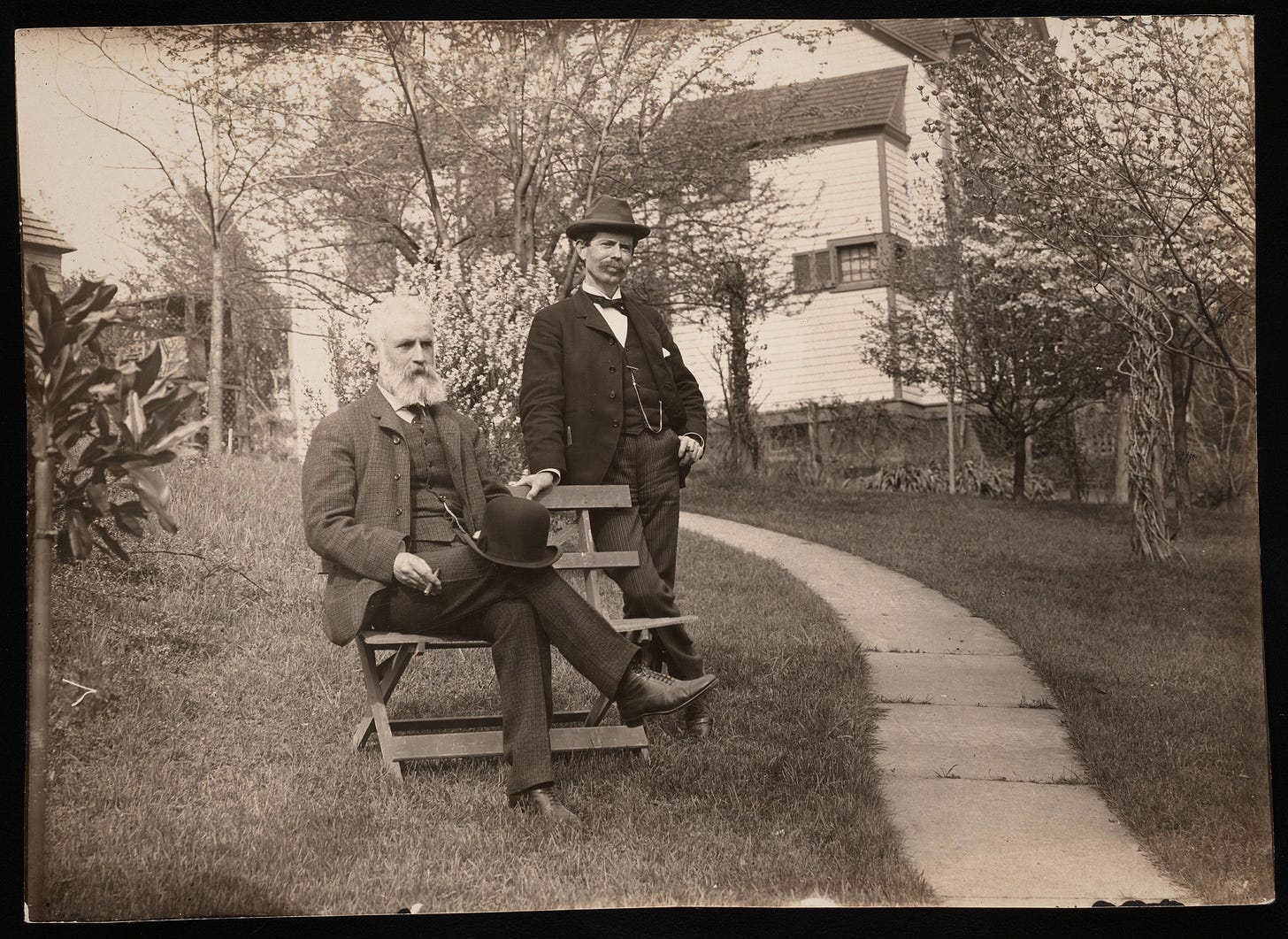Birding legends took on the House Sparrow
The first order of business for a pre-eminent ornithology organization: dealing with a most persistent opponent.

The first meeting of the American Ornithologists’ Union (AOU)1 was a who’s who of 19th century ornithology. William Brewster was there, along with Eugene Bicknell, Charles Cory, Charles Bendire, Robert Ridgway, and Elliott Coues. Spencer Baird and J.A. Allen were unable to attend but they were among the founding officers, and Edward Nelson was named an active member. These are the namesakes, in order, of the Brewster’s Warbler, Bicknell’s Thrush, Cory’s Shearwater, Bendire’s Thrasher, Ridgway’s Rail, and Grace’s Warbler (named after Coues’ daughter). There also are the Baird’s Sandpiper, Allen’s Hummingbird, and Nelson’s Sparrow. That last one has special significance for Chicago.
While honorific nomenclature will soon be a thing of the past—in 2023 it was announced that these names will be changing—seeing all these names and people in one place resonated with this author at a deep level. It also provided more context for how these species ended up named after people. And nearly all men at that.
The periodical Forest and Stream was there to cover the initial meeting that took place at the American Museum of Natural History in New York City in 1883. Six committees were appointed to carry out the work of the AOU. The sixth of the committees quickly caught my eye: Eligibility or Ineligibility of the English House Sparrow in North America.
House Sparrows now feel like a constant topic of conversation in birding and birding-adjacent circles. They’re ever-present in our most urban environments and all over our suburban backyards and really anywhere with human habitation. Distinguishing a male House Sparrow from a female House Sparrow is one of the first identification challenges for a new birder. Males are reddish-brown with a black bib, white cheeks, and a gray crown. Females are brownish-gray with noticeably striped backs in shades of brown, buff, and black.
But if we think House Sparrows are often a subject now, they were a really big deal in 1883, posing significant social, economic, and political issues. There’s a reason why the pre-eminent birders of the 19th century created an entire committee to focus on Passer domesticus. They were that pressing of a problem. By this time, the “Sparrow War” had been raging for nearly 30 years. It had been since the first English Sparrows were brought to the United States in 1852 to eat caterpillars that had been defoliating elm trees.
At first glance, the sparrow item on the AOU agenda reads as a somewhat simple question about listing a non-native species. We just experienced this here in Illinois with the European Goldfinch. State ornithological committees look to a set of criteria to determine if an exotic species has established itself as a self-sustaining breeding population. Until then, observations of the bird don’t count officially. Think of the Mandarin Ducks you see at the zoo, or the escaped one on a farm pond. They’re fun and all, but they really can’t be counted on your eBird checklist for that day.
The European Goldfinch has been officially listed now because it has: 1) Been breeding in a contiguous area of Wisconsin and Illinois; 2) Its population is large enough to survive routine mortality or nest failure; 3) The population has bred in the state for at least 15 years. By 1883, the House Sparrow had surely met these criteria in most places. In reading more, it seems the eligibility question in the 1880s was much more subjective and nuanced. It wasn’t about breeding status—it was about benefit to the environment, other birds, and people. Many of the questions had to do with what the sparrows actually were eating. It had been a while since it was clear it wasn’t just caterpillars—or almost any caterpillars at all. In fact, the sparrows were accused of devastating crops and backyard gardens. The other question had to do with whether they were displacing native birds. There were several differing views on these points, and likely among the ornithologists gathered in New York in 1883. Some defended criticisms of the sparrow that suggested it was aggressive toward robins. On the other side was Elliot Coues, who described the sparrow as “noxious” and “a plague” and “objectionable.” Coues was the Vice President of the of the newly founded AOU. Coues’ home is a national landmark now in the DuPont Circle neighborhood of Washington D.C.
The sparrow debate would continue to rage on for at least another few decades. One of the outcomes was the introduction of bounty laws, whereby state governments rewarded hunters for sparrow skins. Forest and Stream and many others lamented these laws and didn’t see how they could be enforced or result in a meaningful impact on the birds’ population. Other approaches included encouraging sport shooters to use sparrows instead of pigeons and tapping into sparrows as a foodstuff. However, at least according to one account, “sparrows on toast” was hardly a treat for diners.
Compared to the 19th century, we are in a sort of detente with house sparrows now. However, the tensions still come up when talking about species like the Purple Martin, whose existence has been threatened by cavity-nesters like House Sparrows and European Starlings. That the debate about native versus exotic birds goes all the way back to 1883 shows that these are issues not easily resolved. House Sparrows are certainly eligible for listing now, and our yards, parks, and urban areas would feel a little emptier without them.
The American Ornithologists’ Union merged with the Cooper Ornithological Society in 2016 and became the American Ornithological Society. It’s now the world’s largest professional organization for ornithologists.





I love House Sparrows.
Many a bluebird would be thankful if house sparrows disappeared.